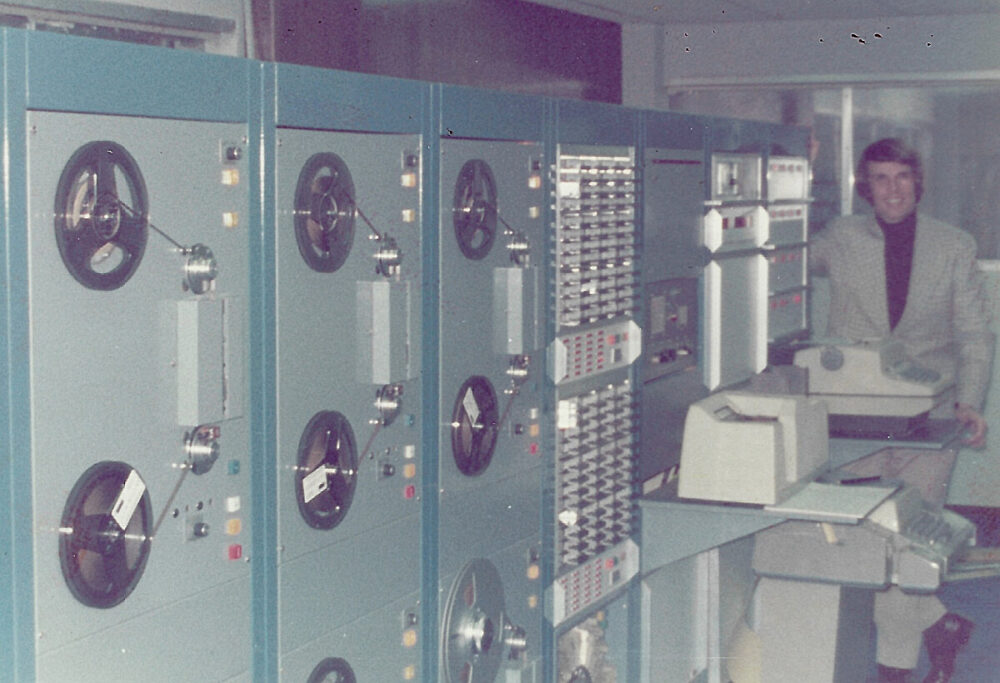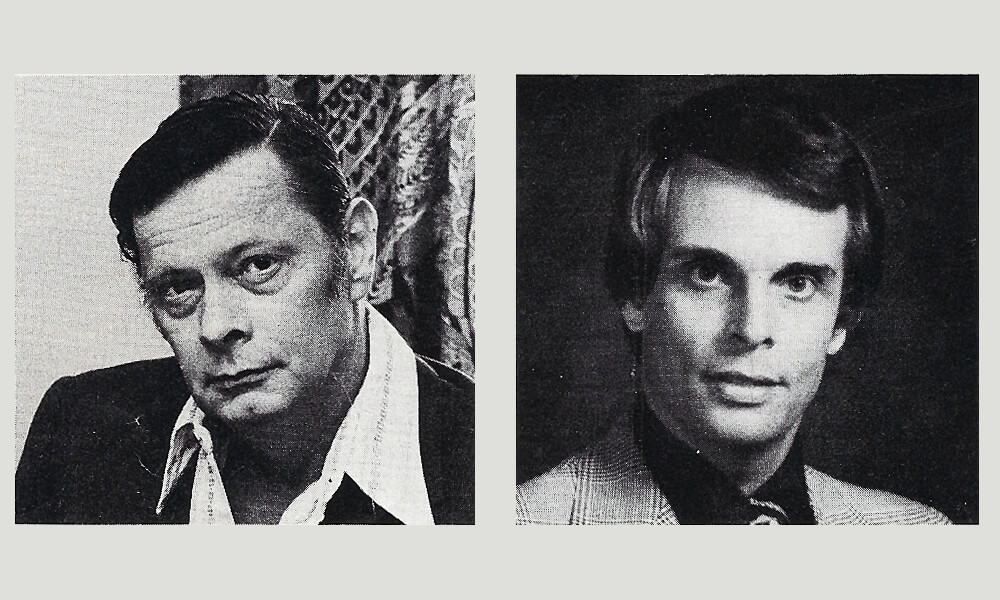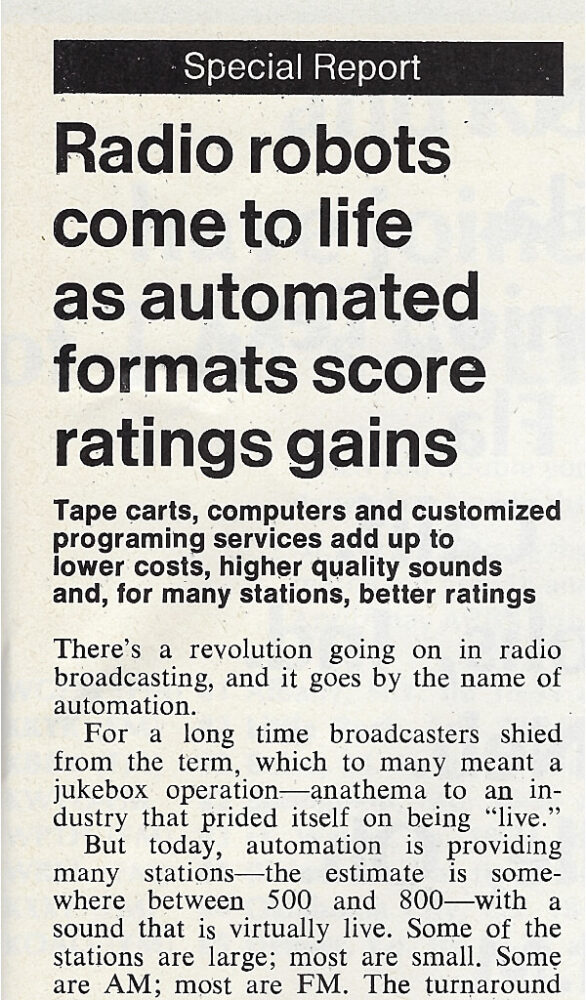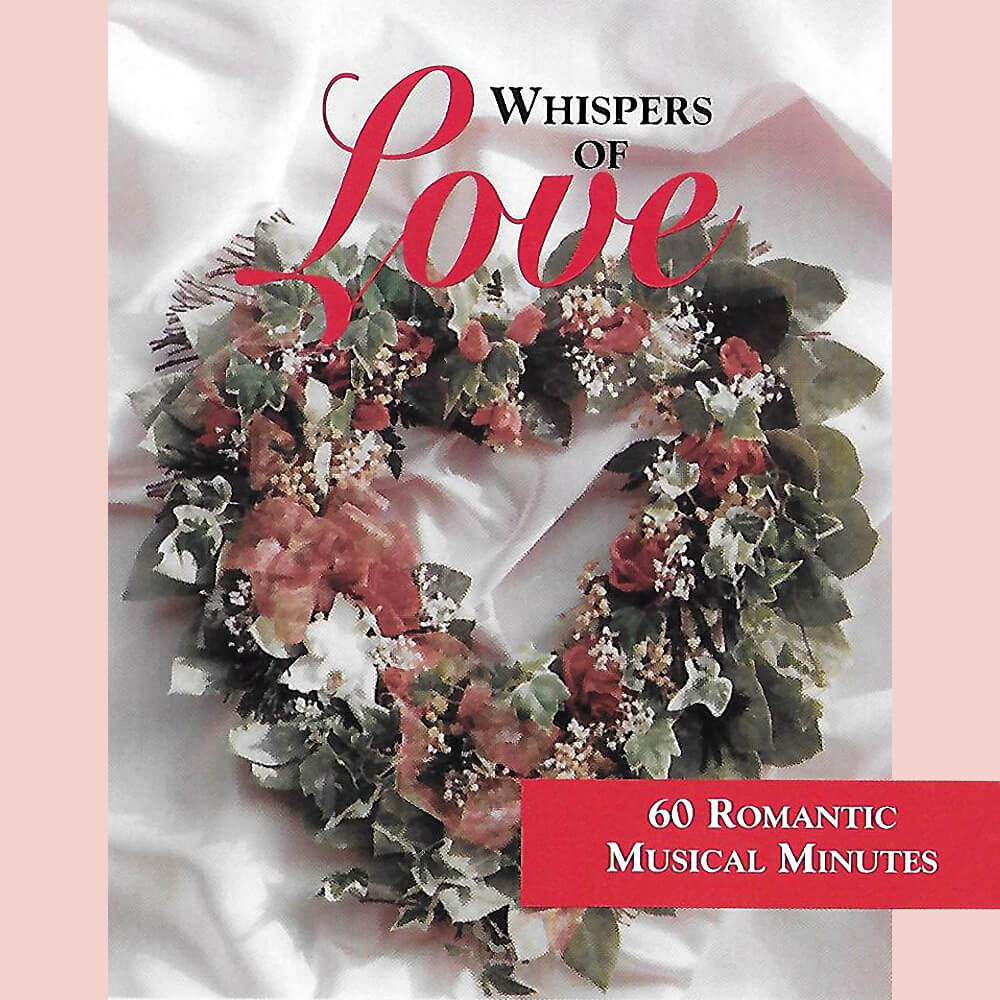In case you don’t recognize us, the gentleman on the left is James A. Schulke, the proprietor of Stereo Radio Productions (SRP) … my arch-competitor in the realm of Beautiful Music programming services. (That, of course, is me in the right picture.) Initially known as Schulke Radio Productions, SRP grew out of a partnership between Jim and Robert E. Richer. They had formed QMI — Quality Media, Incorporated, for the purpose of specifically representing FM stations to the advertising community. Along the way, they recognized the successful ratings that WDVR Philadelphia and WJIB Boston had achieved by programming primarily instrumental arrangements of popular melodies (as created by yours truly at both of these stations). They then focused on representing FM stations that achieved substantial ratings by airing this format … as they saw it, it was a route to a profitable enterprise.
However, they quickly discovered that finding persons capable of replicating what I was doing was close to an insurmountable hurdle. The only answer was to assemble the music pre-programmed on reels of tape for delivery to stations with which they could secure contracts. These contract terms included detailed instructions on exactly how the station would operate and sound. It’s what’s known as “syndication.”
SRP began operations in later 1968 … I would enter the fray in late 1970 after being asked by Arch Madsen, President of Bonneville International Corporation and owner of WRFM New York, to take on programming Bonneville’s newly-acquired WCLR in Chicago. Long story short, he soon wanted me to provide the same programming to Bonneville’s other four FM’s. Simple logic said, if packaging for a half-dozen stations, why not scale up and offer the same content in non-competing markets? That led to what, in1974, was known as Bonneville Broadcast Consultants!
Before I get further off-track, the pictures above appeared in the September 23, 1974 issue of Broadcasting magazine, the broadcast industry’s premier trade publication having its beginnings in 1931 and remaining so through most of the 20th century. They were part of a multi-page feature article appearing under this headline:
This is how BROADCASTING described and quoted me in the article:
The idea that automated stations are nothing but jukeboxes, playing so-called background music, causes Marlin Taylor of Bonneville Broadcast Consultants to bridle. He calls it “foreground” music because he says no one can hear without noticing it. Mr. Taylor, who is out of WRFM (FM) New York and other Boneville-related stations, feels a need to provide customers with a programming service related to market needs and station operations. Bonneville’s formats are conservative, adult listening. Clients, which number 50-plus, were supplied with 200 hours of programming — sufficient for eight days without repeating. Also, as do other services, BBC provides special hours of holiday music.
Each subscriber gets individual attention. “We guide ownership and management in such areas as sales, promotion, and engineering,” Mr. Taylor says.
I apologize for the poor and faded quality of this next photo, which I just recently discovered — it’s of yours truly standing next to the programming automation system at KBIG Los Angeles.

In the Summer of 1971, I was on hand to install our format and train the air staff in handling the non-music elements. Notice the small reels. We provided our programming in half-hour blocks in these early days, with two quarter-hour segments per reel. By 1974 we had devised an integrated playback formula that permitted utilizing larger reels carrying four quarter-hour segments, allowing for a greater walk-away time at the station level.
Back in this era, the government required operators who had both an AM and FM station to program them separately for at least part of the day. By investing in an automation system, one person could handle the operation of both stations. In many cases, this was an announcer/DJ doing a live show on the AM station while minding the FM station being run by the “robot.”
While not nearly all stations utilized an automation system to gain hours of walk-away, un-attended time, many others did. Either way, the success of the individual station certainly can be tied to how much “love” and attention the overall sound received from management and staff. One such station — one of our earliest non-Bonneville client stations and one that was fully automated was WEZO in Rochester, New York. Its sister station was a daytime-only Country Music AM station with live disk jockeys. It wasn’t long before it gained the attention of music lovers throughout the Rochester area and retained its top-ranked position for many years. Here’s how I wrote about WEZO in my Taylor Report, a regular letter sent to the managers of client stations, and their national ranking based on the vast percentage they had claimed of their market’s total radio listening time:
If you’d like to read the entire Broadcasting Magazine multi-page article just follow this link: September 23, 1974 issue on Page 33. This website is a wonderful treasure trove of World Radio History, where you’ll find virtually every issue of the magazine available to be read cover-to-cover — look for the date I’ve noted.
I’d like to share one final item found in the June 1974 issue of my Taylor Report with you. While the particular station referenced in the original article was not identified, I will always wonder if it wasn’t Phoenix’s KMEO-FM, another of our very early and long-time successful Bonneville client stations!
Your thoughts, questions, comments are always welcome! Just scroll below to leave us a message.
Next time, we’ll be very much into the holiday season. By then, many radio stations across the nation will already have been airing non-stop Christmas music for an entire month!






Schulke and Bonneville really made their mark. In the 1970's, their stations were #1 in market after market. I have always felt the Beautiful Music stations of the early 70's were one of the main catalysts that brought FM into its own. Beautiful Music stations got the radio onto the FM dial in homes, paving the way for other formats. Top 40 FM's proliferated, bringing the children of Beautiful Music listeners over to FM.
I love reading your historical stories and your perspective on the business of which I was a part (like you) for so
many years. I actually had some "pre-bonneville" automation experience in 1958 at KLUB where I announced
the music for what we called "Sammy Seaburg". This was the programming for our all-night show. We deejays
were known as KLUB's Fabulous Five, announcing and hosting rock 'n roll programming in the late 50s and
early 60s.including my San Antonio job with McLendon's KTSA where I was program director. Marlin, you
always new me as a salesman and manager so this note may fill you in on the other experience I had in radio.
Hope you'll keep Marlin's Musings continuing. Thanks. DICK DIXON
Mr. Dixon,
Hello sir. You taught me a very important lesson, "Nothing happens in business with a salesman."
Later in my career I parlayed that knowledge into a lucrative sales career in education.
Thank you.
Hello Marlin,
Great article, as always. Brings back lots of good radio memories. One small point: if I recall correctly, SRP started out as Stereo Radio Productions and eventually became Schulke Radio Productions because everyone called the program service "Schulke" anyway. I even think Jim commented about that when they made the change.
Best,
John Timm, Ph.D.
This is very interesting because I began in radio in the 70s, starting at a small station in Arcata, CA that used a syndicated service called Kalamusic. At 15, I obtained my 3rd class FCC license with broadcast endorsement and entered the business as an automation "babysitter". The Kalamusic (7 1/2") reels were in quarter hour segments, however I can't remember the content of the "Kalamusic" back then. Later the station ran Bonneville programming and I still have some of the large reels of tapes I salvaged, that were intended for the dumpster. A few years later while working at another small market station, I was inspired to develop a self-created music format for an AM station that I programmed in Crescent City, CA. Because I was young, but had an old soul, I created the music format in the "MOR" style. I chose a 5-song pattern of categories in quarter-hour segments. I recorded a series of large reel tapes that had the 5-song categories followed by trigger tones that engaged other elements like commercials and news in the automation.
In 2002, I decided to create an online-only radio station, as a hobby using the first incarnation of the Live365 radio network. My co-workers at my ad agency wanted something to listen to "in the background". So, I made up the format that I developed in my 20s at the small market station in Crescent City, and it was noticed by iTunes! They added my stream and essentially hardwired it into anyone's computer or iPod with iTunes back then. Humboldt 101 was born. It was essentially the same MOR format with beautiful music overtones. I found that listeners responded favorably to it. Almost 20 years later, I use the same formatics with the stream and it's more popular than ever; in a lot of cases, to a new, younger audience! I tell friends that "I was streaming when streaming wasn't cool," to coin an old Barbara Mandrell country tune. In recent years, I have connected with people who have guided me to purchase all the Surrey House and Starborne material, to add depth to the beautiful music component of the format. I'm fortunate to have made these wonderful connections.
I have met wonderful people who are close to the music, and those who merely enjoy listening to it. I try to be a preservationist of the style and feel of this music; not unlike the one of the topics of one of the last conversations I had with my friend, Vera Conniff. She recognized the power of my online station and was very supportive, as was her husband, Ray. She was adamant about wanting me to preserve and perpetuate the music. As I approach my 20th anniversary of a hobby that is rooted in my passionate radio past, I intend to follow through, as long as I'm able, with my promise to Vera.
Having been a lifelong Rochester resident, I have fond memories of WEZO and its signature voice of Mr. Jerry Warner who recorded the station IDs, time checks, and hosted a live weekday morning show — the only portion of WEZO’s program day that was not fully automated. WEZO quickly conquered the top position in Rochester radio, cannibalizing the audience of the competing easy listening station in the market, then WPXY “Pixie 98,” which I recall favoring more uptempo music and slightly more vocals than Bonneville’s format. WPXY quickly changed to a top-40/CHR station by the late 1970s as Rochester contemporary music fans began migrating from AM pop stations like WBBF and WWWG to FM.
The early days of WEZO were a bit of a mess — that station was notorious for airing the wrong time checks, but this was corrected. The station delivered a powerful signal across the region and attracted all the usual high class advertisers (Cadillac dealers, country clubs, banks, etc.) that targeted its older audience. Its owner Malrite Communications would eventually launch Rochester’s first independent TV station WUHF by 1980. WEZO also was a favorite station on Christmas Eve and Day when it aired at least 30 hours of Christmas music long before some stations went all Christmas music by November.
The biggest noticeable change to WEZO came in the 1980s just a few years before its demise. It rebranded as “Satellite Stereo” and evidently by this time Bonneville was either programming its stations with a satellite feed or at least delivered content to its affiliates that way.
Remarkably the demise of the format came swiftly across the country and so it did here in the mid-1980s when WEZO was replaced by WRMM “Warm 101.3,” a vocal heavy, soft adult contemporary station. A rimshot station in the Finger Lakes region south of Rochester tried to fill the easy listening niche as “Wish 95” — WZSH in Bristol, but that flopped. Years later I learned that Jerry Warner did not simply retire to play golf. He ended up at one or two of the regional AM stations that serve communities near Rochester. He passed away just a few years ago.
Thank you, Phillip, for sharing those memories “from the scene.”
As for satellite delivery, Bonneville did offer that for a few years in the mid-1980’s when the offering of formatted around-the-clock via satellite was just beginning. I did not remember that WEZO that took that feed.
And, regarding messed-up timechecks, that was not uncommon . . . a regular reader of these Musings was a college kid when hired at a major market FM as a part-time “machine minder.” After eons of the station’s automation system being an embarrassment, he finally took the time to learn and understand and “teach” the machine how to “behave” – it was not necessarily easy back in those days, when staff members were not available or willing to devote the needed time. Sadly, a number of our client stations treated their FM as the “poor step-child,” yet many would go on to be the one which was the most profitable.